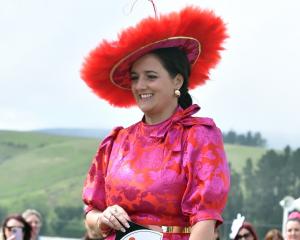
The first glimpse of the dress only heightened the sense of anticipation.
It was almost completely shielded from view as Catherine Middleton stepped quickly into the Rolls-Royce outside her hotel for the drive to Westminster Abbey.
Then women around the world - and more men than might care to admit it - held their breath as her car pulled up for her to alight. The anticipation was almost palpable.
By then, many in the world of fashion had recognised the woman who had assisted her into the car at the hotel entrance. There was little doubt that this unheralded helper was Sarah Burton, the creative director of British fashion house Alexander McQueen.
Her presence set off a ripple of approval and a feeling of elation even before the bride stepped from the vehicle.
And, when she did, surely no-one was disappointed in the striking beauty of the bride and her wedding dress. For this was a once-upon-a-time gown where fairy stories begin.
Almost two weeks on from the Royal Wedding the gown's British-ness, its design attributes and the craftsmanship involved in its making is well documented.
But what did Dunedin designers think? We asked a couple.
"I think Kate Middleton's dress was a lesson in understated elegance. It was restrained from a design perspective, yet sculptural, interesting from all angles, with a beautiful silhouette. The fit was immaculate and it swept aside any comparisons to Princess Di and was reflective of Kate's personal style.
"Sarah Burton was always my pick. I was expecting a more dramatic back and train, and I thought that it would have more ornate and embellished beadwork. I was a little surprised at the veil length and thought the silk tulle sat a little flat. In saying [that], I liked that it was a female designer who was willing to compromise her handwriting to allow Kate such a big part of the design process.
"If Lee [Alexander] McQueen had designed it, I'm not sure that we would have seen that dress. I was sure she'd be wearing lace, which is also such a signature of the House of McQueen, as is its use of British craftsmanship.
"It's fantastic to see a move away from the white strapless wedding gown that has dominated weddings for the last 10 years. I loved the Grace Kelly-inspired transparency of the lace teamed with the silk. I would love to see more use of classic laces this summer. One of the factors in the success of Kate's dress is the extraordinary quality of the fabrics used."
"To me it was perfectly designed for the person and the identity Catherine has now and will become in the future.
"It was elegantly beautiful, with hallmarks of the designer but always taking into account the modesty of the client. Of course, what a fabulous body for which to design a dress! "The beautiful lace bodice and sleeves enhanced the bride's appearance, the amazing layered bustle, although initially screened by the veil, fell so beautifully with the train; it just suited the bride perfectly.
"To me this gown will still look fabulous in years to come when who knows what the rest of the world will be wearing. It didn't scream '2011'. "The maid of honour [Philippa Middleton] equally quietly elegant, wore a gown that was perfectly made in that with every step it flowed, wrinkle-free, which can be tricky with that style of bias-cut dress. It was very sophisticated; and lovely to see no suggestion of frou-frou.
" I was so happy it was Alexander McQueen, one of the most accomplished designers to ever come out of the United Kingdom, and whose departure [from this life] was so untimely.
Sarah Burton has done, and will continue to reflect the true style of McQueen. It was great to see that the gown wasn't a daring catwalk garment - often a media-only piece and not really meant to be worn by real people.
"I would hope that future brides take a leaf out of Kate's book and realise that they don't need ostentatious gowns to make them the centre of attention. It's their day, they are the focus anyway.
And, hopefully, New Zealand brides won't do copycat dresses; that's scary!"
The accessories
• The veil: Kate's veil was transparent, made of ivory tulle and trimmed with hand-embroidered flowers. It was embroidered by the Royal School of Needlework.
• The tiara: The priceless Halo Tiara was made by Cartier in 1936 and lent to Kate by the Queen. The tiara was bought by the Duke of York, later King George VI, for his wife Elizabeth, and passed to the Queen on her 18th birthday.
• The jewellery: The earrings were diamond-set stylised oak leaves with a pear-shaped diamond-set drop and a pavé set diamond acorn suspended in the centre. The custom earrings, designed by Robinson Pelham, were a gift from the bride's parents.
• Dress embellishments: Flowers such as thistles, roses, daffodils and shamrocks were embroidered on to the wedding gown. The details were hand-cut from Chantilly lace. The gown's skirt was handmade by the Royal School of Needlework, at Hampton Court.
• The bouquet: A shield-shaped wired bouquet of myrtle, lily-of-the-valley, sweet William and hyacinth. It drew on the traditions of flowers of significance for the Royal Family and the Middleton family.
Roundup
As Tim Blanks, writing for Style.com said following the highly successful Alexander McQueen collection show at Paris Fashion Week in March this year: "It felt much more like Burton wanted to remind the planet that she isn't channelling the McQueen DNA, she is the McQueen DNA." His anti-establishment sentiments are well-known but McQueen also enjoyed ritual and pageantry. This gown would surely have passed muster.












